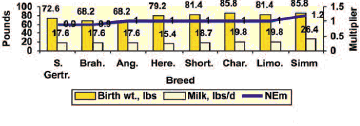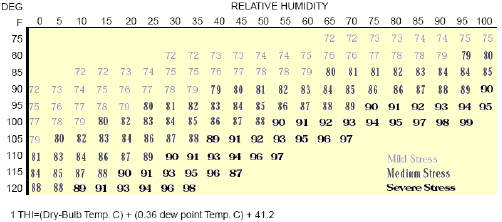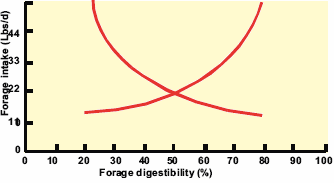



Effects Of The Environment On The Nutritional Needs Of Grazing Livestock
By Alvaro Garcia, Extension dairy specialist and Cody Wright, Extension beef specialist. South Dakota State University Cooperative Extension Service. Profitability of grazing operations is related to productivity per acre.
Productivity is determined, among other factors, by the efficiency with which the animal harvests the forage. Efficiency can be defined as nutrients consumed per unit of product produced (feed to gain). Costs incurred in this process which are not translated into products are sources of inefficiencies.
Costs are not only related to dollars spent by livestock producers but also to nutrient inputs and outputs (balance) incurred by an animal. Just as in your bank account, the animal has a budget in his body with accretions and withdrawals, and when one exceeds the other they can either build up or deplete reserves.
Nutrients consumed by cattle provide maintenance and production. Energy, one of the most critical nutrients for grazing ruminants, is supplied by the end products of nutrient fermentation and absorption. Energy is used to maintain body temperature, is lost as heat of fermentation, or is used while performing work (e.g. walking). An energy balance is the result of the difference between inputs (energy intake) and outputs (energy expenditure).When positive, it may result in body weight gain and increased production and reproduction. A negative energy balance, on the other hand, can decrease production and/or body condition and ultimately affect fertility.
Walking while grazing or between grazing paddocks and drinking water expends energy. The distance cattle walk daily varies both within days and between days on individual farms and is generally related to pasture availability and/or accessibility.
Ruminants try to match their feed intake and energy requirements. Distance traveled by grazing cattle is determined by a combination of intrinsic animal characteristics and management decisions. Grazing behavior under these conditions will be determined, among other factors, by pasture quality/ availability and level of supplementation.
Supplementing cows on pasture is thus sometimes needed to achieve energy equilibrium and increase production and profit. The amount and type of supplement to use depends on each particular situation. In general, economics plays a major role in this decision. Although immediate responses in production are often expected, the cost effectiveness of medium- and long-term supplementation programs on production and reproduction should also be considered.
Factors affecting energy requirements of grazed cattle
A breed’s walking ability should be evaluated when animals are required to forage over large areas. Large-framed breeds have to carry heavier loads when they are grazed.
In addition, as the lean mass of an animal increases, so does its maintenance energy requirements. Although visceral tissues are a relatively small portion of the body weight, they consume nearly 50% of maintenance energy. Larger framed animals have larger organs and thus maintenance energy expenditure increases accordingly. At the same time, energy expenditure due to muscle activity in grazing cattle might also be significant depending on the terrain of the pasture.
Simmentals have higher energy requirements than Angus cattle after adjustments for metabolic body weight are made (Fig 1). A difference in maintenance requirements depending on season has also been suggested, with Simmentals having the lowest maintenance requirements in summer and Angus in winter. Santa Gertrudis and Brahman have 90% of the requirements of Angus, Hereford, Shorthorn, Charolais, and Limousin, whereas Simmentals had the highest requirements.

Fig 1. Maintenance requirement multiplier, birth weights, and peak milk production (NCR 1996).
Ruminants also balance feed intake and energy requirements during the reproductive cycle. From a maximum at peak milk production for a cow nursing a calf, nutrient demand decreases with days in milk. Requirements increase again in the last month of pregnancy due to fetus development (Fig 2). As lactation progresses there is a negative effect on daily intake of nutrients. In cows calving in the spring, daily intake of organic matter and digestible organic matter decreases from late spring to autumn.

Fig 2. Nutrient requirements of beef cows (NRC 1996).
The behavioral aspects of grazing have been defined as either “intense” or “search” grazing. Intense grazing, typically seen when good quality forage is easily available, is characterized by numerous bites without moving to a new feeding station. Searching behavior involves a few bites at one feeding station and then moving to another and will be seen either with low forage quality/availability or toward the end of a grazing bout. Grazing activity can increase when a new paddock or strip is offered.
Landscape
Among the main factors that have been frequently observed to determine cattle distribution in a pasture are the slope of the terrain, distance to the water source, and pasture characteristics.
Water availability determines how extensive each grazing bout can be, as dry matter intake is closely related to water intake. It has been estimated that the optimum grazing area resembles a circle with the water source at its center and a radius of approximately half a mile, particularly during the summer. This distance changes depending on forage availability and thus increases during a drought. Location of the water source is less important during the winter when free water in the form of snow is available on the forage (Bailey et al. 1996). The need for water has to be weighed against energy obtained from the pasture available and energy expended while walking to harvest the pasture.
Cattle have been described as having spatial memory that helps them find areas with high quality forage that they have grazed before.When introducing a group of animals to a new grazing area it is thus useful to include some that are already familiar with that environment. This enhances the use of the pasture, particularly during years or seasons of limited forage supply by reducing the learning curve of the recent arrivals.
Season and temperature
Although the effects of season have generally been associated with those of ambient temperature, there is increasing evidence that season itself can have an effect on maintenance requirements of cattle. It has been noted that cattle maintenance requirements are lower during the fall and higher during the spring. It has also been reported that as cow fatness increases, maintenance requirements increase during spring and summer but decrease during the fall and winter.
Heat is produced inside the animal as part of its tissue metabolism and from fermentation in the digestive system. Heat dissipation from the animal is through evaporation, radiation, convection, and conduction. In order to maintain a constant body temperature (thermostasis), there needs to be a balance between heat production and dissipation. The thermo neutral zone is defined as the effective environmental temperature in which cattle are neither under heat or cold stress, metabolic rate is minimal, and the animal needs neither heat dissipating nor conserving mechanisms (usually around 41 to 68 F).
Whenever ambient temperatures increase beyond the thermoneutral zone, mechanisms to dissipate heat are triggered (increased respiration and heart rate), and as a result, maintenance requirements increase. Similarly, maintenance requirements also increase during cold weather as the animal needs to generate heat in order to maintain body temperature.
Animals also change their behavior to cope with climate extremes. Grouping up and changing the direction of the body to decrease the surface body area exposed to cold wind are energy-saving strategies. On the other hand, during hot days animals will seek shade, wind, or water to wade in. This is not to be confused with bunching behavior on hot summer days, usually a result of trying to avoid fly nuisance.
During hot summer days, to lose significant heat through evaporative cooling, the relative humidity of the environment has to be low. The stress from a combination of ambient temperature and relative humidity is measured as the temperature humidity index (THI; Fig 3).When the THI physiological mechanisms (e.g. sweating, panting) and behavioral changes (e.g. searching for cooler spots) designed to cope with the rising external temperatures reach max and the animal has exhausted these heatabating options, the remaining alternative is to reduce intake, in particular that of high fiber feeds as they generate the most heat of fermentation in the rumen. As a result, acidosis is oftentimes observed during the summer because animals sort through their feed and look for smaller feed particles that are easier to digest.

Fig 3. Temperature Humidity Index (Wiersma, 1990, University of Arizona).
The opposite is also true during the winter when animals will choose stemmy forages to maintain body temperatures during cold weather. The effects of extreme cold weather also are alleviated by changes in cattle behavior, such as orientating themselves during cold windy winter days. Solar radiation lowers metabolic requirements, especially on cold, clear days. This helps the animal conserve energy and suggests solar radiation should be taken into account when selecting winter pastures or husbandry practices.
Environmental and animal factors contribute to heat loss. Environmental factors are: wind, precipitation, humidity, and thermal radiation. Several factors contribute to heat losses by conduction, convection, and radiation from the animal. Among those factors are surface area, (including external insulation) and tissue insulation (subcutaneous fat deposits). Tissue insulation is related to how much fat is deposited under the skin as well as the skin thickness, which increases with age. The external insulation is related to the hair depth as modified by wind, mud, and precipitation.
Time of day
As digestibility of the forage declines cattle have to ruminate more, which results in less time spent grazing. The time of the day when most grazing activities occur is determined by climate and in particular by ambient temperatures.
With ambient temperatures at or close to the cattle thermo neutral zone, grazing occurs mostly during the day. During hot summer days, there’s a shift in grazing patterns with more early morning, late afternoon, and night grazing. Night grazing is performed in the area close to where it ended in the evening as there is little directional grazing at night.
If rotational grazing is used during warm weather, animals should be assigned high quality paddocks particularly in the evening to maximize the daily grazing hours, improve pasture utilization, and optimize performance.
During cold winter, most grazing occurs during daytime with increased activity particularly during the afternoon when it’s warmer. Under extreme cold weather the animal physiologically compares the energetic cost of travel with that of the energy harvested from the limited forage available. It is possible that in spite of greater energy needs due to weather, the animal chooses to maintain energy reserves by not moving rather than go in search of limited, and more than likely, low quality forage.
Forage quality and availability
Animal performance depends on the intake of digestible nutrients. Forage quality and availability thus play major roles in pasture based production systems.
Pasture availability might influence quality of herbage eaten due to animal selectivity. Herbage availability can be affected by plant density per surface area and/or stocking rates. At lower pasture densities animals need to walk more to meet their nutrient requirements. Energy expenditure might thus offset the advantage of selecting higher quality forage. Availability, although not affecting quality directly, will then affect its efficiency of utilization.
At higher stocking rates animals are pushed to graze closer to the ground. Quality, and thus energy supplied by the forage, decrease while energy expenditure due to activity becomes less important. Increasing stocking rates may also induce more dominant/submissive behavior, which can modify feed intake. As forage availability decreased to 500 lb/acre there was a fourfold increase in rate of consumption and a twofold increase in time spent grazing.
Regulation of feed intake
Under grazing conditions, feed intake is regulated by a balance between gut fill and clearance of feed from the rumen (digestibility). There is general consensus that energy intake is regulated rather than intake of specific individual nutrients. Feed intake is determined by an integration of physiological, physical, and psychogenic mechanisms.When high-quality, high-energy forages are fed, energy is regulated by the physiological energy demand. In other terms, the animal will graze until the energy requirements are met provided there are no other constraints (e.g. adverse environmental conditions).With high-fiber, low-energy forages (e.g. corn stalks, straw, etc.), physical fill limits intake; the animal eats until the rumen distension causes the cessation regardless of whether intake of energy is enough to fulfill requirements (Fig 4).

Fig 4. Relationship between forage digesibility and long-term forage intake patterns (modified from Conrad, 1964).
Choosing the right supplement
When supplementing grazing cattle, the objective is to balance otherwise deficient nutrients and do so in an efficient and profitable manner. From everything addressed above it is clearly important to take into consideration the feeds and the season. For example, feeds that generate excessive heat of fermentation are inappropriate as a supplement during hot summer days but are necessary during the winter. On the other hand, supplementing with concentrates during hot weather, although they increase the nutrient density of the diet and produce less heat of fermentation, may result in cases of sub-clinical to clinical acidosis and may reduce the rate of fiber digestion.
Energy is probably one of the first limiting nutrients under grazing conditions. Energy is mostly derived from mature pastures and forages of lower digestibility that result in the intake of less total digestible nutrients. Energy deficiency can be primary (resultant of low forage fiber digestibility) or secondary to a suboptimal level of other nutrients such as protein. For the case of a secondary energy deficiency, supplementing with the nutrient which is deficient (e.g. nitrogen) will result in increased digestible organic matter being utilized by the rumen microbes. In instances where sparse and/or overly mature pastures are grazed, you often will see a combined energy/protein deficiency rather than that of a single nutrient.
Minerals and vitamins are also important nutrients to take into consideration. Of the macro minerals (those present in greater concentration in the diet) phosphorus, sodium, and chlorine are the most likely to be deficient under range conditions. Magnesium deficiency can present as grass tetany, which occurs during pasture growth during spring or fall.
Deficiencies should always be a concern when animals graze pastures that have been under stress (e.g. drought) over a prolonged period of time.
Cobalt, copper, iodine, manganese, selenium, and zinc of the micro or trace minerals are more than likely the ones that will be deficient under range conditions. However, in certain areas selenium may be present in concentrations that are potentially toxic. This can occur via selenium accumulator plants or via traditional native or tame grasses. It is also possible that secondary deficiencies can be caused by mineral antagonisms. This is particularly true for copper. Iron, molybdenum, and sulfur are all potent antagonists against copper absorption. In pastures that are mature and dry, beta-carotenes, which are precursors of vitamin A, are often deficient. Plants pro-vitamin content can be assessed fairly accurately by looking at their color. Green indicates the presence of beta-carotenes, whereas a yellowish color indicates their depletion and/or oxidation. Under these circumstances it is also more than likely than vitamin E can also be deficient.
Wrap-up
The environment plays an important role in the ability of animals to perform according to expectations. Energy is usually one of the first limiting nutrients; its deficiency results from an imbalance between intake and expenditure, and it is greatly influenced by environmental conditions. An energy deficiency can also be secondary to suboptimal levels of protein in the diet.
Among the factors that play a big role in the energy balance are ambient temperatures and work performed by the animal.
Choosing the right supplement is important not only from an economic perspective but also from an animal performance standpoint.
Fibrous roughages of limited digestibility are best utilized during cold weather when heat of fermentation is useful in maintaining the animal’s body temperature.
References
Bailey, D.W., J.E. Gross, E.A. Laca, L.R. Rittenhouse, M.B. Coughenour, D.M. Swift, P.L. Sims. 1996. Mechanisms that result in large herbivore grazing distribution patterns. J. Range Manage 49: 386-400.Conrad, H.R., A.D. Pratt, L.W. Hibbs. 1964. Regulation of feed intake in dairy cows. 1. Change in importance of physical and physiological factors with increasing digestibility. J Dairy Sci 47: 54-62.
NRC. 1996 (2000 update). Nutrient Requirements of Beef Cattle, 7th ed. Natl Acad Press,Washington, DC.
Wiersma, F. 1990. THI for dairy cows. Department of Agricultural Engineering. University of Arizona, Tucson.
September 2007


